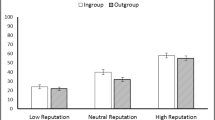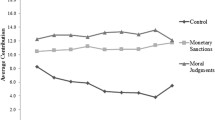Abstract
Several everyday examples imply that humans reciprocate not only towards direct perpetrators, but also to entire groups, thereby potentially affecting innocent bystanders. We test the hypothesis that people are predisposed to reciprocate against groups. In a laboratory experiment, subjects who were helped or harmed by another player’s action reacted by helping or harming another member of that player’s group. This group reciprocity was only observed when one group was seen as unfairly advantaged. Thus, activation of group reciprocity may be a causal mechanism that links perceived injustice to intergroup conflict. We discuss the relevance of group reciprocity to political and economic phenomena including violence, discrimination and team competition.




Similar content being viewed by others
Notes
It was forbidden to communicate personal information. All subjects followed these instructions.
100 ECU per subject were described as an endowment for the second part of the experiment. To ensure that each subject had at least 100 ECU, minimum group earnings of 400 ECU were implemented. This endowment was purely a framing manipulation to increase subjects’ sense that they had “earned” their ECU.
The reason for the imbalance between the number of sessions in each treatment is as follows: we wished to examine individual-level correlates of group reciprocity, so we ran extra sessions using the random bonus treatment which turned out to induce group reciprocity. Note that our results are significant when aggregating across all types of sessions.
By “harm”, we simply mean “reduce the other’s earnings”. We cannot be sure whether our subjects perceived taking from the common fund as harmful or simply as not helpful, since this depends on what they perceived to be the default or baseline action.
Subjects might become more generous to other members of their own group in the face of an external threat (e.g. Sherif et al. 1961). To avoid this potential confound, we ensured that P2 was never from the subject’s own group.
In third party repetitions, we also varied whether the feedback player P1 was playing against someone from the subject’s own group, or someone from a different, neutral group. This allows us to examine whether subjects react more strongly when P1’s action affects a member of the subject’s own group. As overall results from third party treatments were null, we do not report further on this here.
Two of our sessions used only the first party treatment.
The online appendix shows participants’ descriptive statistics, including demographics.
A derivation is in the online appendix.
These include removing the fixed effects; using session- rather than individual-clustered standard errors; adding controls for the history of play; and running Tobit regressions.
This is within random bonus sessions only. Results are similar in winner bonus sessions. Controlling for fairness perceptions reduces, but does not eliminate, the difference between sessions.
In fact, there were no significant correlations within groups.
If we do not multiply impute Expectations, we lose all repetitions other than 2 and 7. Results on repetitions 2 and 7 alone are insignificant whether or not Expectations are included.
Expectations was imputed from the following variables: first round amount taken by participant F, first and second round amounts taken by the subject and his/her own round 1 and round 2 partners, lags of these amounts from the previous repetition; amount the subject last saw taken by a participant from the same colour group as the current partner; a quadratic in repetition (from 1 to 8), and treatment dummies.
To gather more information, these sessions only included first party treatments, with two repetitions of each color treatment.
A pooled linear regression without fixed effects also gives a significant result at 5%. A Tobit model and a linear regression model including controls for the history of play did not reach significance, although the coefficients had the same signs.
References
Abbink, K., and Herrmann, B. (2009). Pointless Vedettas. http://papers.ssrn.com/sol3/papers.cfm?abstract_id=1468452. Accessed 10 July 2017.
Alm, J., & Torgler, B. (2006). Cultural differences and tax morale in the United States and Europe. Journal of Economic Psychology, 27, 224–246.
Arrow, K. J. (1972). Some mathematical models of race discrimination in the labor market. In H. P. Anthony (Ed.), Racial discrimination in economic life (pp. 187–203). Lexington (Mass.): Lexington Books.
Aureli, F., Cozzolino, R., Cordischi, C., & Scucchi, S. (1992). Kin-Oriented Redirection among Japanese Macaques: An expression of a revenge system? Animal Behaviour, 44(2), 283–291.
Ball, S., & Eckel, C. C. (1998). The Economic Value of Status. Journal of Socio-Economics, 27(4), 495–514.
Bauerlein, M. (2001). Negrophobia: A race riot in Atlanta, 1906. New York: Encounter Books.
Bernhard, H., Fischbacher, U., & Fehr, E. (2006). Parochial altruism in humans. Nature, 442(7105), 912–915.
Bornhorst, F., Ichino, A., Kirchkamp, O., Schlag, K., & Winter, E. (2010). Similarities and differences when building trust: The role of cultures. Experimental Economics, 13(3), 260–283.
Bornstein, G. (1992). The free-rider problem in intergroup conflicts over step-level and continuous public goods. Journal of Personality and Social Psychology, 62(4), 597.
Bornstein, G. (2003). Intergroup conflict: individual, Group, And Collective Interests. Personality and Social Psychology Review, 7(2), 129–145.
Brass, P. R. (1997). Theft of an idol: Text and context in the representation of collective violence. Princeton, NJ: Princeton University Press.
Brewer, M. B. (1999). The psychology of prejudice: Ingroup love and outgroup hate? Journal of Social Issues, 55(3), 429–444.
Cederman, L. E., Weidmann, N. B., & Gleditsch, K. S. (2011). Horizontal inequalities and Ethno-Nationalist Civil War: A global comparison. American Political Science Review, 105(3), 478–495.
Chagnon, N. A. (1988). Life histories, blood revenge, and warfare in a tribal population. Science, 239(4843), 985–992.
Chen, R., & Chen, Y. (2011). The potential of social identity for equilibrium selection. American Economic Review, 101(6), 2562–2589.
Chen, Y., & Li, S. X. (2009). Group identity and social preferences. American Economic Review, 99(1), 431–457.
Cherry, T. L., Frykblom, P., & Shogren, J. F. (2002). Hardnose the dictator. American Economic Review, 92(4), 1218–1221.
Currarini, S., & Mengel, F. (2012). Identity, homophily and in-group bias. FEEM Working Paper 37.
de Cremer, D., & van Vugt, M. (1999). Leadership in social dilemmas: The effects of group identification on collective actions to provide public goods. Journal of Personality and Social Psychology, 76(4), 587–599.
Dufwenberg, M., Gneezy, U., Güth, W., & Van Damme, E. (2001). Direct vs indirect reciprocity: An experiment. Homo Oeconomicus, 18, 19–30.
Falk, A., Fehr, E., & Fischbacher, U. (2003). On the nature of fair behavior. Economic Inquiry, 41(1), 20–26.
Falk, A., & Fischbacher, U. (2006). A theory of reciprocity. Games and Economic Behavior, 54, 293–315.
Fearon, J. D., & Laitin, D. D. (1996). Explaining interethnic cooperation. American Political Science Review, 90(4), 715–735.
Fehr, E., & Gächter, S. (2000). Cooperation and punishment in public goods experiments. American Economic Review, 90(4), 980–994.
Fershtman, C., & Gneezy, U. (2001). Discrimination in a segmented society: An experimental approach. Quarterly Journal of Economics, 116(1), 351–377.
Fischbacher, U. (2007). z-Tree: Zurich toolbox for ready-made economic experiments. Experimental Econics, 10(2), 171–178.
Fischbacher, U., Gaechter, S., & F, E. (2001). Are people conditionally cooperative? Evidence from a public goods experiment. Economics Letters, 71(3), 397–404.
Gaertner, S. L., Dovidio, J. F., Anastasio, P. A., Bachman, B. A., & Rust, M. C. (1993). The common ingroup identity model: Recategorization and the reduction of intergroup bias. European Review of Social Psychology, 4(1), 1–26.
Gaertner, L., Iuzzini, J., & O’Mara, E. M. (2008). When rejection by one fosters aggression against many: Multiple-victim aggression as a consequence of social rejection and perceived groupness. Journal of Experimental Social Psychology, 44, 958–970.
Glaeser, E. L. (2005). The political economy of hatred. Quarterly Journal of Economics, 120(1), 45–86.
Goette, L., Huffman, D., & Meier, S. (2006). The Impact of group membership on cooperation and norm enforcement: Evidence using random assignment to real social groups. American Economic Review, 96(2), 212–216.
Greiner, B. (2004). The Online Recruitment System ORSEE 2.0—A guide for the organization of experiments in economics.University of Cologne Working Papers Series in Economics, p. 10.
Greiner, B., & Levatti, V. M. (2005). Indirect reciprocity in cyclical networks. An experimental study. Journal of Economic Psychology, 26, 711–731.
Guala, F. (2012). Reciprocity: Weak or strong? what punishment experiments do (and Do Not) demonstrate. Behavioral and Brain Sciences, 35(1), 1.
Güth, W., Schmittberger, R., & Schwarze, B. (1982). An experimental analysis of ultimatum bargaining. Journal of Economic Behavior & Organization, 3(4), 367–388.
Habyarimana, J. P., Humphreys, M., Posner, D. N., & Weinstein, J. M. (2009). Coethnicity: Diversity and the dilemmas of collective action. New York: Russell Sage Foundation Publications.
Hardin, R. (1995). One for all: The logic of group conflict. Princeton: Princeton University Press.
Hargreaves-Heap, S., & Zizzo, D. J. (2009). The value of groups. American Economic Review, 99(1), 295–323.
Hoff, K., Kshetramade, M., & Fehr, E. (2011). Caste and punishment: The legacy of caste culture in norm enforcement. The Economic Journal, 121(556), F449–F475.
Horowitz, D. N. (1985). Ethnic groups in conflict. Berkeley: University of California Press.
Horowitz, D. N. (2001). The deadly ethnic riot. Berkeley: University of California Press.
Kaufman, S. J. (2001). Modern hatreds: The symbolic politics of ethnic war. Ithaca: Cornell University Press.
Keynes, J. M. (1922). The economic consequences of the peace. Los Angeles: IndoEuropean.
Klein, J. G., & Ettensoe, R. (1999). Consumer animosity and consumer ethnocentrism. Journal of International Consumer Marketing, 11(4), 5–24.
Leong, S. M., Cote, J. A., Ang, S. H., Tan, S. J., Jung, A. K., Kau, Keng, et al. (2008). Understanding consumer animosity in an international crisis: Nature, antecedents, and consequences. Journal of International Business Studies, 39(6), 996–1009.
Lickel, B., Miller, N., Stenstrom, D. M., Denson, T. F., & Schmader, T. (2006). Vicarious retribution: The role of collective blame in intergroup aggression. Personality and Social Psychology Review, 10(2), 372–703.
Mummendey, A., Simon, B., D, C., G, Melanie, Haeger, G., Kessler, S., et al. (1992). Categorization is not enough: Intergroup discrimination in negative outcome allocations. Journal of Experimental Social Psychology, 28, 125–144.
Rabin, M. (1993). Incorporating fairness into game theory and economics. American Economic Review, 83(5), 1281–1302.
Shayo, M., & Zussman, A. (2011). Judicial ingroup bias in the shadow of terrorism. The Quarterly Journal of Economics, 126(3), 1447–1484.
Sherif, M., Harvey, O. J., Jack White, B., Hood, W. R., & Sherif, C. W. (1961). The Robbers cave experiment: Intergroup conflict and cooperation. Scranton: Wesleyan University Press.
Stanca, L. (2009). Measuring indirect reciprocity: Whose back do we scratch? Journal of Economic Psychology, 30(2), 190–202.
Stenstrom, D. M., Lickel, B., Denson, T. F., & Miller, N. (2008). The roles of ingroup identification and outgroup entitativity in intergroup retribution. Personality and Social Psychology Bulletin, 34, 1570–1582.
Tambiah, S. J. (1996). Leveling crowds: Ethnonationalist conflicts and collective violence in South Asia. Berkeley: University of California Press.
Weisel, O., and Zultan, R. (2013). Social motives in intergroup conflict. Jena Economic Research Papers 2013-033.
Zussman, A. (2012). Ethnic Discrimination: Lessons from the israeli online market for used cars. Working paper.
Acknowledgements
This work was supported by British Academy Small Research Grant SG101553. We thank Astrid Buba, Vittoria Levati, Werner Güth, Eva Steiger, Johannes Weisser, Ro’i Zultan, David Reinstein, Ryan McKay, Eva van den Broek, Shaun Hargreaves Heap, Brian Lickel, Arthur Lupia, Tore Ellingsen, Lorenz Goette, Alicia Melis, Michelle Brock, Catherine Scacco, Rafael Hortalla-Vallve, Nadine Chlass, Matthew Braham and seminar participants at the Max Planck Institute of Economics, University of Hamburg, University of Warwick, King’s College London, University of East Anglia, NYU-CESS, IMEBE, ESA and THEEM for helpful comments; and the Max Planck Institute ESI group hiwis and administrative staff: Martin Beck, Nadine Erdmann, Adrian Liebtrau, Christian Williges, Christian Streubel, Claudia Zellmann and especially Christoph Göring.
Author information
Authors and Affiliations
Corresponding author
Rights and permissions
About this article
Cite this article
Hugh-Jones, D., Leroch, M.A. Intergroup Revenge: A Laboratory Experiment. Homo Oecon 34, 117–135 (2017). https://doi.org/10.1007/s41412-017-0049-0
Received:
Accepted:
Published:
Issue Date:
DOI: https://doi.org/10.1007/s41412-017-0049-0




